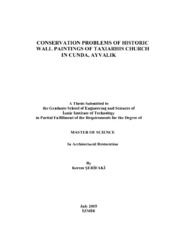Please use this identifier to cite or link to this item:
https://hdl.handle.net/11147/3312Full metadata record
| DC Field | Value | Language |
|---|---|---|
| dc.contributor.advisor | Böke, Hasan | en |
| dc.contributor.author | Şerifaki, Kerem | - |
| dc.date.accessioned | 2014-07-22T13:51:18Z | |
| dc.date.available | 2014-07-22T13:51:18Z | |
| dc.date.issued | 2005 | en |
| dc.identifier.uri | http://hdl.handle.net/11147/3312 | |
| dc.description | Thesis (Master)--Izmir Institute of Technology, Architectural Restoration, Izmir, 2005 | en |
| dc.description | Includes bibliographical references (leaves: 73-77) | en |
| dc.description | Text in English;Abstract: Turkish and English | en |
| dc.description | xii, 77 leaves | en |
| dc.description.abstract | In this study, wall paintings of the Taxiarhis Church were investigated with the purpose of conservation. Wall paintings are documented by photographs and drawings. It was aimed to determine the application technique and material properties of the paintings. Wall paintings of the Taxiarhis Church were executed in two different periods. Hence, samples including all periods were collected. Basic physical properties, raw material compositions, chemical and mineralogical compositions and micro structures of the plaster layers were determined. Chemical and mineralogical compositions and the microstructure of the painting layers and weight loss of the binder due to heat were determined. These studies were carried out by X-Ray diffraction (XRD), scanning electron microscope, thermogravimetric analyzer (TGA), Differential scanning calorimeter (DSC) and infrared spectroscopy (FT-IR).Wall paintings were executed on fine lime plaster by using vegetable oils (linseed, walnut, poppy seed, etc.) by oil painting technique. Wall paintings of both periods were executed on fine lime plasters. Vegetable oil mixed with ZnO was used in the preparation of binding media. Priming layer over binding layer is composed of Anglesite (PbSO4) and vegetable oil. Pigments that gave the color to the paintings were executed on the priming layer and may be defined as green earth, lead red and iron oxide. Vandalism is an important effect in the deterioration of the paintings. Beside this, crack formation on the paint surfaces and disintegration of the fine plaster and paint layers due to the wetting drying cycles are observed. Deteriorations observed on paintings will be prevented by the consolidation of the structure and the control of the dampness.Keywords: Taxiarhis Church, Wall painting, Linseed oil, Oil painting, Cunda. | en |
| dc.language.iso | en | en_US |
| dc.publisher | Izmir Institute of Technology | en |
| dc.publisher | Izmir Institute of Technology | en_US |
| dc.rights | info:eu-repo/semantics/openAccess | en_US |
| dc.subject.lcc | NA5870.T2 .S48 2005 | en |
| dc.subject.lcsh | Taxiarchis Church in Cunda | en |
| dc.subject.lcsh | Church architecture--Turkey--Ayvalık--Conservation and restoration | en |
| dc.subject.lcsh | Churches--Protection--Turkey | en |
| dc.subject.lcsh | Mural painting and decoration--Protection--Turkey | en |
| dc.subject.lcsh | Church decoration and ornament--Turkey | en |
| dc.title | Conservation problems of historic wall paintings of Taxiarhis Church in Cunda, Ayvalık | en_US |
| dc.type | Master Thesis | en_US |
| dc.authorid | TR41044 | |
| dc.institutionauthor | Şerifaki, Kerem | - |
| dc.department | Thesis (Master)--İzmir Institute of Technology, Conservation and Restoration of Cultural Heritage | en_US |
| dc.relation.publicationcategory | Tez | en_US |
| item.languageiso639-1 | en | - |
| item.fulltext | With Fulltext | - |
| item.openairecristype | http://purl.org/coar/resource_type/c_18cf | - |
| item.openairetype | Master Thesis | - |
| item.grantfulltext | open | - |
| item.cerifentitytype | Publications | - |
| crisitem.author.dept | 02.01. Department of Conservation and Restoration of Cultural Heritage | - |
| Appears in Collections: | Master Degree / Yüksek Lisans Tezleri | |
Files in This Item:
| File | Description | Size | Format | |
|---|---|---|---|---|
| T000393.pdf | MasterThesis | 8.42 MB | Adobe PDF |  View/Open |
CORE Recommender
Page view(s)
212
checked on Jul 22, 2024
Download(s)
670
checked on Jul 22, 2024
Google ScholarTM
Check
Items in GCRIS Repository are protected by copyright, with all rights reserved, unless otherwise indicated.